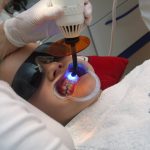When to Stop Using Gauze After Wisdom Teeth Extraction: A Comprehensive Guide

Wisdom teeth extraction is a common dental procedure that involves the removal of one or more wisdom teeth. This procedure is usually necessary when the wisdom teeth cause pain, infection, or other dental problems. After the extraction, patients are often advised to use gauze to control bleeding and promote healing. However, knowing when to stop using gauze can be confusing for many patients. In this comprehensive guide, we will explore the factors that determine when to stop using gauze after wisdom teeth extraction and provide helpful tips for a speedy and successful recovery. When it comes to wisdom teeth extraction, proper aftercare is crucial for a successful recovery. Gauze is an essential component of post-operative care as it helps to control bleeding and prevent the formation of blood clots. However, using gauze for too long can impede the healing process and lead to other complications such as infection and dry socket. Therefore, it is important to know when to stop using gauze after wisdom teeth extraction. In this guide, we will discuss the signs that indicate it is time to remove the gauze and offer practical advice on how to manage any discomfort or bleeding that may occur after gauze removal.
Wisdom teeth extraction is a common dental procedure that involves the removal of one or more third molars located at the back of the mouth. These teeth typically emerge during the late teenage years or early adulthood and can cause discomfort, pain, and even infection if they become impacted or don’t have enough room to grow. The extraction process usually involves administering local anesthesia and making an incision in the gum tissue to access the tooth. The tooth may be removed in one piece or broken up into smaller pieces for easier removal. After the extraction, the patient will experience some discomfort and swelling, and it’s important to follow post-operative instructions carefully to ensure proper healing and minimize the risk of complications.
Gauze is often used after wisdom teeth extraction to control bleeding and promote blood clot formation in the socket. The gauze acts as a barrier to prevent further bleeding, allowing the clot to form and stabilize. Without this clot, the socket remains exposed and can lead to complications such as dry socket. Gauze also helps to absorb any excess saliva or blood that may be present in the mouth, which can be uncomfortable and even cause nausea if swallowed. It is important to follow the instructions provided by your dentist or oral surgeon regarding how long to use gauze after extraction to ensure proper healing and minimize the risk of complications.
How long to keep gauze in after wisdom teeth extraction

After wisdom teeth extraction, it is common to have bleeding for the first few hours. To stop the bleeding, the dentist or the oral surgeon will place a piece of gauze on the extraction site, and ask the patient to bite down on it firmly for 30-45 minutes. The gauze helps to form a blood clot, which is essential for the healing process. It is important to change the gauze every 30-45 minutes or as necessary until the bleeding has stopped. Once the bleeding has stopped, the gauze should be removed, and the patient should not use any more gauze unless there is bleeding again. The length of time to keep gauze in after wisdom teeth extraction varies from person to person. Typically, the gauze is used for a few hours after the extraction. However, it may be necessary to use the gauze for a longer period of time if the bleeding continues. If the bleeding persists for more than 24 hours, it is important to contact the dentist or oral surgeon. The dentist may need to examine the extraction site to determine the cause of the bleeding and provide additional treatment if necessary. In general, it is important to follow the dentist’s instructions carefully to ensure proper healing after wisdom teeth extraction.
Initial gauze use is a crucial step in the postoperative care of patients who have undergone wisdom teeth extraction. The primary purpose of gauze is to control bleeding and facilitate blood clotting in the surgical site. After the procedure, the dentist or oral surgeon will place the gauze in the extraction site and ask the patient to bite down gently for about 30 minutes. This pressure will help to stop any bleeding and promote the formation of a blood clot. Besides, gauze also helps to protect the surgical site from debris and food particles that may interfere with the healing process. While gauze is essential in the first few hours after surgery, it is crucial to follow the dentist’s instructions on when to stop using it to avoid any further complications.
After wisdom teeth extraction, it is crucial to follow proper aftercare instructions to promote healing and prevent complications. One of the essential components of aftercare is using gauze to control bleeding and promote clotting. Typically, patients are advised to keep the initial gauze in place for about 30-45 minutes after the procedure. This time allows the blood to clot and for the initial bleeding to subside. After this time, the gauze should be removed, and patients can replace it with fresh, clean gauze as needed. It is essential to follow the instructions provided by the oral surgeon or dentist carefully to ensure proper healing and minimize the risk of post-operative complications.
Knowing when to replace gauze after wisdom teeth extraction is crucial to ensure proper healing and minimize the risk of infection. Generally, it is recommended to change the gauze every 30-45 minutes or as needed, especially if it becomes saturated with blood. After the bleeding has subsided, the frequency of gauze replacement can be reduced. It is important to follow the instructions provided by your dentist or oral surgeon, as every case is unique and may require different care. Additionally, if you experience excessive bleeding or pain, consult with your healthcare provider immediately. Proper care and attention during the healing process can make a significant difference in the outcome of the procedure.
What to do after initial gauze removal

After the initial removal of gauze following wisdom teeth extraction, it is important to continue to follow post-operative care instructions to minimize pain, swelling, and the risk of infection. It is recommended to avoid any strenuous physical activity or heavy lifting for at least 24-48 hours to prevent dislodging the blood clot that is forming. Additionally, it is important to continue to rinse the mouth gently with warm salt water every few hours to keep the extraction site clean and promote healing. As the days pass, it is normal to experience some swelling and discomfort, but this can be managed with ice packs and over-the-counter pain medications. It is also important to maintain a soft diet during the first few days of recovery and avoid consuming any hot or spicy foods that may irritate the extraction site. Smoking and drinking alcohol should also be avoided, as they can delay the healing process and increase the risk of complications. If any unusual symptoms, such as excessive bleeding, fever, or severe pain, are experienced, it is important to contact the dentist or oral surgeon immediately. By following these post-operative care instructions, patients can ensure a smooth and successful recovery after wisdom teeth extraction.
Rinsing your mouth after wisdom teeth extraction is an essential step in the healing process. It helps to remove any food particles or debris that may have accumulated in the surgical area, reducing the risk of infection. To rinse your mouth, take a small amount of warm salt water or mouthwash and swish it gently in your mouth for about 30 seconds. Do not gargle or spit forcefully, as this can dislodge the blood clot and delay the healing process. Repeat this process two to three times a day, especially after meals or snacks. Remember not to use a straw, as the suction can also cause the blood clot to dislodge. By following these simple instructions, you can ensure a speedy and successful recovery after your wisdom teeth extraction.
If bleeding persists after gauze removal following wisdom teeth extraction, there are several steps you can take to stop the bleeding. First, rinse your mouth gently with saltwater to remove any blood clots. Next, apply a fresh piece of gauze to the affected area and bite down firmly for at least 30 minutes. If the bleeding still does not stop, try applying a moistened tea bag to the socket and biting down for another 30 minutes. The tannic acid in the tea can help constrict blood vessels and promote clotting. If the bleeding persists after these measures, contact your oral surgeon or dentist immediately for further guidance and treatment. It is important to follow post-operative instructions carefully to ensure a smooth and successful recovery.
After the gauze has been removed following wisdom teeth extraction, it is important to avoid certain things to promote healing and prevent complications. First and foremost, avoid smoking or using tobacco products as they can delay the healing process and increase the risk of infection. It is also advisable to avoid drinking through a straw, as the suction can dislodge the blood clot and lead to a painful condition called dry socket. Additionally, hard and crunchy foods should be avoided as they can irritate the extraction site and cause discomfort. Instead, opt for soft and easy-to-chew foods to promote healing. Finally, it is important to continue practicing good oral hygiene habits, such as gently brushing and rinsing with saltwater, to keep the extraction site clean and free from bacteria.
Signs that it’s time to stop using gauze

Gauze is a common material used after wisdom teeth extraction to control bleeding and promote healing. However, there are certain signs that it’s time to stop using gauze and switch to other methods of wound care. One of the most obvious signs is when the bleeding has significantly decreased or stopped. If the gauze is no longer soaking up blood and is instead just becoming saturated with saliva, it’s time to stop using it. Continuing to use gauze in this situation can actually interfere with the healing process by removing the protective blood clot that forms over the extraction site. Another sign that it’s time to stop using gauze is when the extraction site starts to feel more comfortable. In the first few hours after the procedure, it’s common to experience pain and discomfort. However, as time goes on, the pain should start to subside. When the extraction site is no longer causing significant discomfort, it’s a good indication that the wound is starting to heal and that gauze is no longer necessary. At this point, it’s important to switch to other methods of wound care, such as rinsing with salt water or using ice packs to reduce swelling.
It can be difficult to determine if bleeding has stopped after wisdom teeth extraction. One way to tell is to gently remove the gauze from the extraction site and check for any active bleeding. If there is no bleeding or oozing, the bleeding has likely stopped. Another way to tell is by the color of the saliva or blood in your mouth. Bright red blood indicates active bleeding, while dark red or brownish blood indicates older blood that has already clotted. It’s important to follow the post-operative instructions provided by your dentist or oral surgeon to ensure proper healing and to seek medical attention if bleeding persists or becomes excessive.
Gauze is commonly used after wisdom teeth extraction to help control bleeding and promote healing. However, it is important to know when it is appropriate to stop using gauze entirely. Typically, gauze should only be used for the first 24-48 hours after surgery. After this time frame, you should no longer need gauze as the bleeding should have subsided. Continuing to use gauze beyond this point can actually hinder the healing process by disrupting the formation of a blood clot and irritating the surgical site. It is important to follow your dentist or oral surgeon’s post-operative instructions carefully to ensure optimal healing and avoid complications.
If bleeding persists after stopping gauze use following wisdom teeth extraction, it is important to take immediate action to prevent further complications. The first step is to apply a new piece of gauze to the affected area and bite down firmly for at least 30 minutes. If this does not stop the bleeding, try using a damp tea bag instead of gauze, as the tannins in tea can help to promote blood clotting. It is also important to avoid any strenuous activity or exercise for the first few days after surgery, as this can increase the risk of bleeding. If bleeding still persists after these measures have been taken, contact your dentist or oral surgeon immediately for further advice and treatment.
Other postextraction care tips

After a wisdom teeth extraction, there are several other postextraction care tips that should be followed in order to promote proper healing and prevent complications. One important tip is to avoid drinking through a straw for at least 24 hours after the procedure. The suction created by drinking through a straw can dislodge the blood clot that forms in the socket, leading to a painful condition called dry socket. Similarly, smoking should also be avoided for at least 24 hours, as the act of inhaling can also dislodge the blood clot. Another important postextraction care tip is to maintain proper oral hygiene. It is important to continue brushing your teeth as usual, but be careful to avoid the extraction site for the first few days. After 24 hours, you can gently rinse your mouth with warm salt water to help keep the area clean. It is also important to avoid any strenuous physical activity for the first few days after the procedure, as this can increase blood flow to the extraction site and lead to bleeding. By following these postextraction care tips, you can help ensure proper healing and reduce the risk of complications after a wisdom teeth extraction.
After wisdom teeth extraction, it is important to stick to a soft food diet for the first few days. Foods that are easy to chew, swallow, and won’t get lodged in the extraction site are ideal choices. These can include mashed potatoes, applesauce, yogurt, smoothies, and soups. It’s also important to stay hydrated by drinking plenty of water and avoiding alcohol, carbonated drinks, and hot beverages. Avoid using straws, as the suction can dislodge the blood clot and delay healing. Additionally, avoiding spicy, acidic, and crunchy foods can help prevent irritation to the extraction site. Proper nutrition and hydration can aid in the healing process and ensure a speedy recovery.
Maintaining good oral hygiene after wisdom teeth extraction is crucial for a speedy recovery. The first 24 hours after the procedure, patients should avoid brushing or rinsing their mouth to prevent dislodging the blood clot. After that, gentle brushing and rinsing with saltwater can help keep the area clean and promote healing. It is essential to avoid using tobacco, drinking alcohol, and consuming hot or spicy foods during the healing process. Patients should also avoid using straws, as the suction can dislodge the blood clot and lead to dry socket, a painful condition that can delay healing. Proper oral hygiene instructions provided by the dentist or oral surgeon can help patients avoid complications and ensure a smooth recovery.
After a wisdom teeth extraction, it is crucial to stay in touch with your dentist to ensure that the healing process is going smoothly. The dentist should provide you with postoperative instructions on how to take care of the surgical site and reduce the risk of infection. It is recommended to follow up with your dentist within a week after the procedure to check the progress of the healing and remove any stitches or gauze that may still be in place. Additionally, if you experience any unusual symptoms such as excessive bleeding, fever, or severe pain, you should contact your dentist immediately to avoid any complications. Regular follow-ups with your dentist will help ensure a smooth and successful recovery.
The article titled \When to Stop Using Gauze After Wisdom Teeth Extraction: A Comprehensive Guide\ provides crucial information for people who have recently undergone wisdom teeth removal surgery. The key points discussed in the article include the importance of using gauze pads to control bleeding following the surgery and the recommended duration of use, which is typically between 30 minutes to an hour. The article also advises against using gauze for more than a few hours as it can delay the healing process and cause complications such as dry socket. Other important takeaways from the article include the necessity of following post-operative instructions provided by the dentist or oral surgeon, adopting a soft-food diet, and avoiding smoking and drinking alcohol during the healing period.
After a wisdom tooth extraction, proper postoperative care is essential for a quick and smooth recovery. It is recommended to avoid smoking, drinking through a straw, and rinsing your mouth vigorously for at least 24 hours after the surgery. Additionally, it is crucial to keep the extraction site clean by gently brushing your teeth and tongue, and using a saltwater rinse or an antiseptic mouthwash as directed by your dentist. Applying a cold compress to your cheek for 10-20 minutes at a time can also help reduce swelling and discomfort. Lastly, following a soft diet for the first few days and gradually reintroducing solid foods can help prevent any complications and promote healing. If you experience severe pain, bleeding, or any other unusual symptoms, contact your dentist immediately.
Conclusion

In conclusion, knowing when to stop using gauze after wisdom teeth extraction is crucial to ensure proper healing and prevent complications. While it is important to follow the instructions provided by your dentist, it is also essential to pay attention to your own body and any signs of bleeding or discomfort. Remember to change gauze regularly and avoid activities that may disrupt the blood clot. With proper care and attention, you can ensure a smooth and comfortable recovery from wisdom teeth extraction.







